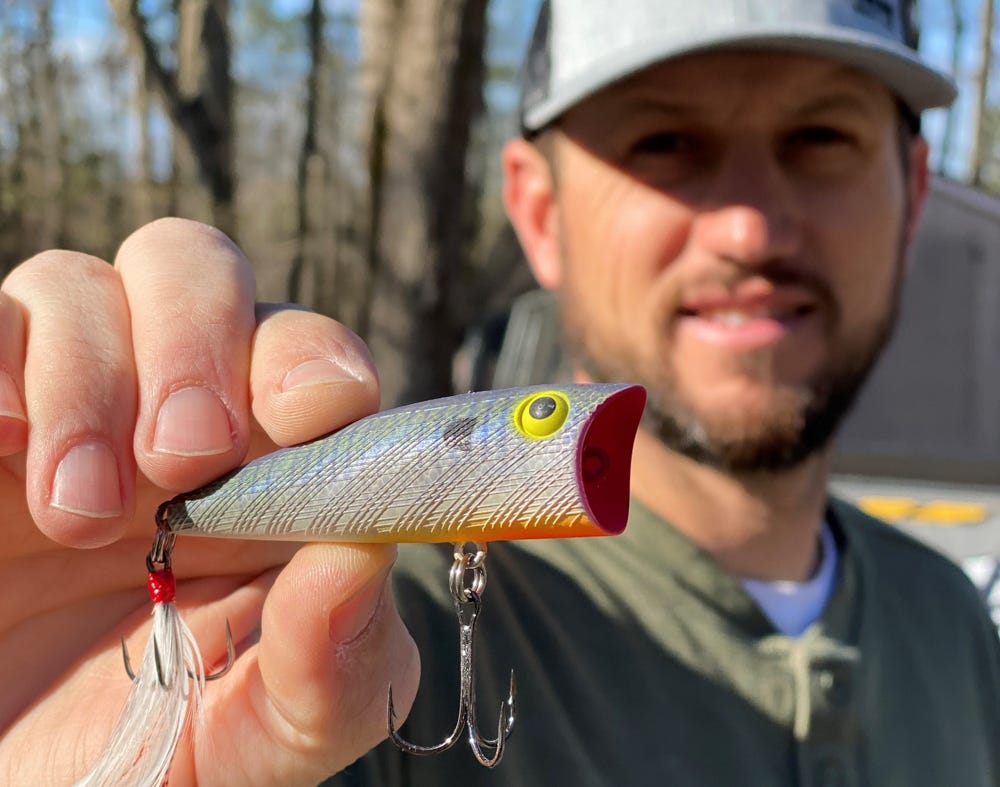- Mar 4, 2021
Rebel Lures Revives Classic Pop-R Design
The new Rebel Pop-R P71 delivers the attributes of the iconic P70 Pop-R in response to demand from anglers across the country.
“It does everything the P70 did,” Arkansas bass pro Stetson Blaylock said about the new Rebel P71 Pop-R. “It’s heavy, so you can roll cast it under docks and other cover and lay it in there quietly. It rests tail down, and you can make it move back and forth the while keeping it in the same place.”
Matching the characteristics of the long-discontinued and hard-to-find P70 is a big deal to Blaylock, because the P70 has been a big-money bait for him that has called up many critical bass in major tournaments, including first- and second-place finishes in consecutive Bassmaster Elite Series events on Winyah Bay and Lake Hartwell in spring 2019.
At Lake Hartwell, a P70 produced a key catch with a “slow motion strike” that was caught on film and has become legendary among tournament bass fishing fans.
P71 Basics


Measuring 3 1/8 inches and weighing 9/16 ounce, the new P71 perfectly matches the size, shape and action of the legendary P70. As importantly, the P71 is made from butyrate, providing the proper buoyancy for spitting and popping and the low-pitched rattle that traditionally has helped set apart the P70 from other popping lures.
A large popper already, the Pop-R P71 is engineered for optimized casting, which is important for making long casts to avoid spooking fish. Excellent castability is also critical for making precise presentations to the tight spots where big fish like to lie in ambush position during spring.
Other important P71 features include a larger front treble to increase hook-up rates and a feather-dressed back treble for added attraction as it dangles in front of fish between pops.
Target Fishing


Blaylock is excited about using the P71 this spring, because the pre-spawn to spawn period, when bass tend to be shallow and close to cover, is when the original P70 has produced the most success for him.
“For me it’s a target-specific bait,” Blaylock said. “It’s ideal for getting a specific fish out of a specific spot.”
Key areas for spring fishing with a P71 Pop-R are commonly quite tight – beneath overhanging branches, between limbs of laydowns or under docks – so Blaylock uses a roll cast to keep the bait close to the water and propel it to his chosen target. Accuracy and a quiet landing are critical, which is why the P71’s 9/16-ounce weight and highly castable design are so important.
The P71 also rests almost vertically in the water, and when worked with quick short snaps, it walks and splashes from side-to-side without moving far at all, which aggravates fish into biting.
“I cast to a high-percentage spot and then twitch it a few times to make it walk in place,” Blaylock said. “If nothing hits it, I reel it back and cast to the next target.”
Pockets of shade, whether under a dock, a bank overhang or a low-hanging bush, are Blaylock’s go-to spots for his approach.
Making Fish Strike


Topwater specialist Hiro Naito doesn’t believe in waiting for fish to strike. Instead he keeps his lure working where he expects fish to be and controls his presentations to prompt fish to attack. An important virtue of the P71 Pop-R for Naito’s approach is that he can easily create a wide range of sounds and actions by varying his rod movements.
Beyond the unique in-place walking action that’s already been noted, a P70 produces a classic Pop-R pop, which imitates a baitfish fleeing a predator, when worked with quick but sharp snap of the rod tip. A longer pull, with the line tight, makes the same bait chug, which imitates a feeding fish and often is key to getting the fish’s attention.
“If a fish is facing in the wrong direction, it won’t see your lure, so it doesn’t matter what you do,” Naito said. “Chugging your lure at the right time will get them to turn in the right direction.”
The P71 is also distinctive among topwater lures because with quick successive rod snaps, you can actually get it to dip barely beneath the surface and cause it to dart from side to side as a subsurface walker. Often a few subsurface zigzags added at just the right time will prompt a bass that has been following to attack.
Naito strategically mixes all of these sounds and actions, along with others that fall in-between, to trigger attacks from bass. He generally positions his boat fairly close to the bank, and he relies on accurate casts to shallow cover or over submerged cover. He works his Pop-R for as long as he feels like it is in a primary fish-holding area, adding triggering actions in key spots. When he thinks he’s out of likely zone, he reels back quickly and makes another cast.
Pop-R P71
The Pop-R P71 comes in six colors, including old-school standards and a few outstanding new colors. While bass fishermen will make the most use of this Pop-R, its large size also makes it a very good choice for striped bass, northern pike and inshore saltwater species like redfish and speckled trout.



